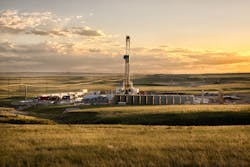Oil production requires water, both in conventional well drilling sites as well as hydraulic fracturing ( fracking) production. However, there are different types of water in play from water injected into the wells to water that comes up with the oil. In some of the more unconventional fields in the U.S. where oil is produced, estimates from the American Geosciences Institute’s 2018 report Water in the Oil and Gas Industry place usage at 10 barrels of water for every barrel of oil pumped from the ground. This represents a significant cost to producers and operators as the cost of produced water treatment and disposal can be as high as $5 per barrel. To help manage these costs, many producers and operators are turning to instrumentation to measure and track the flow of water through their systems and the treatment and disposal sites.
In all instances of water used, there are strict guidelines to adhere to, including environmental and accounting regulations. And although those may differ from country to country, meeting the stated requirements can be a challenge, depending on the type of measurement equipment used.
When selecting measurement devices to best monitor produced water, it helps to consider not just price but also durability. A meter with moving parts, for example, will be subject to wear from debris in the water and in the long run may cost more.
Injected Water or Pumped Up Water
Whether water is injected for hydraulic fracturing or pumped up along with the hydrocarbon, knowing exact amounts of water flowing through the pipes or the well is of critical importance. Increased regulation and environmental scrutiny make an accurate accounting of water critical.
There are a number of specific instances that require accurate water management, including:
• Potential corrosivity and salinity of the water impacting pipes and equipment
• Quality of the separation process
• Maintenance of the correct mixture of slurry (water and sand) when injecting
Corrosive water, which is water that might contain chemicals or particles and bacteria, or water with a high saline content, can damage equipment and piping. Water with a high saline content (brackish water) is bound by strict environmental rules relating to how it can be used. For example, it cannot be used for irrigation as it will damage soil and plants. As a result, brackish water is collected and sent to treatment facilities via pipelines or trucks. To help offset the costs of the treatment and disposal, some of the produced water can be reused for injection. However, careful management of how much of this high saline content water is used is critical to avoid salting in the well and rendering it non-productive. To this end, accurate and reliable measurement of the produced water, along with the freshwater it is mixed with, becomes critical to the sustainable operation of the well.
Even in the separation process of water and hydrocarbon, there is the possibility that the water left at the end of that process could be unsuitable for use and would need to be pumped back into the well or into storage tanks for further treatment.
Maintaining a correct slurry mixture to inject into a hydraulic process is essential, otherwise it can clog or damage systems. The injected slurry mixture will also impact what is brought up from the well, which again will include water.
Treating Produced Water
Just like with municipal and industrial wastewater, the treatment of produced water in oil production is required and regulated. In each instance, the requirements dictate that the water be treated and properly disposed of to ensure environmental compliance.
In a typical produced water treatment scenario, the mixture pumped up from the well is fed into separators to remove the oil, which is sent on for further processing. The removed water that is pumped into holding tanks awaits transport to a wastewater disposal or treatment facility (this can be either on-site or offsite). Often, the water is transported to these treatment centers via trucks, which increases the cost impact the water has on operation. To offset these costs, many producers are now investing in pipelines that create their own challenges.
When transporting water from the production holding tanks to the treatment center via pipeline, leak detection becomes critical. As the water is highly saline, spills can have a devastating impact on the area, killing vegetation and making it so the soil cannot support plant life for many years to come. Consequently, accurate measurement of the water throughout the pipeline is critical to enable early identification of any potential leaks. Once at the treatment centers, the water goes through a process of filtration, evaporation, and/or chemical treatment to remove harmful chemicals and salts, debris, and bacteria. Depending on the percentage of salinity, the water might also be stored in saltwater disposal wells.
Technologies to Measure Produced Water
Traditionally, oil well operators have used turbine meters to measure whatever came up from a well. Turbine meters can be cost-effective in the startup phase of a project because they are relatively affordable; however, the fact that they have moving parts makes them vulnerable to wear, especially when used with corrosive materials.
Recently there has been a trend to use alternate technologies that require less maintenance but still provide an accurate and reliable flow measurement. Magnetic flow meters give accurate readings of produced water and slurry flowing through the pipes. Traditionally, these meters have not been considered for the hydrocarbon industry due to the nonconductive nature of most of the fluids. Today, with different exploration methods such as hydraulic fracturing, along with the increased focus on water management, they are quickly becoming the meter of choice for applications where the fluid is conductive.
Magnetic flow meters, or mag meters as they are also known, operate on Faraday’s law of electromagnetism. Instead of moving parts, they have sensors that measure the induced voltage created as a conductive fluid moves through a magnetic field. This induced voltage is proportional to the fluid velocity, which when used with the meter cross-sectional area provides a highly accurate volumetric flow measurement. Since pure water is not conductive, it will not register in a mag meter. But produced water is far from pure and clean; the greater the amount of impurities in the water, the more conductive the fluid will be, increasing the benefits that magnetic flowmeter technology can provide for measuring the fluid flow.
Additional benefits that magnetic flow meters provide over traditional turbine and mechanical meters include the capability to provide advanced diagnostics that indicate when there may be installation, process, or meter health issues that could impact the accuracy of the reading. Diagnostics, such as coating detection, can play an important role in ensuring the meter is reading correctly, especially in leak detection systems where an erroneous reading could shut down the entire system. With paraffin materials and other coatings like iron oxide common in these pipelines, detecting if or when coating is occurring can help prevent these unintended shutdowns and enable a proactive maintenance approach rather than a reactive one.
Meter verification diagnostics also play an important role in an operator’s ability to show compliance with environmental regulations. Magnetic flow meters with internal smart meter verification capabilities can help extend the interval between proving cycles, can be used to generate compliance reports, and can also provide early alerts to a potential issue with the meter. These advanced diagnostics can be used to provide confidence in the meter performance, simplify compliance reporting requirements, and help better utilize limited maintenance staff by only sending them to work on a meter when there is an issue.
Monitoring and Measuring Become Critical
In oil fields, the monitoring and measuring of produced water have become more critical. At a time when meeting environmental standards and regulations can become an administrative headache, having the right measurement tools that make reporting easier is a boon.
Much of the diagnostic data collected from meters today meets reporting standards and is accepted by the agencies requiring the reporting. This reduces time spent tracking down flow totals and does not impact production in any way. Data can be collected from the meter while it is in service by accessing the transmitter’s onboard digital diagnostics. WT



